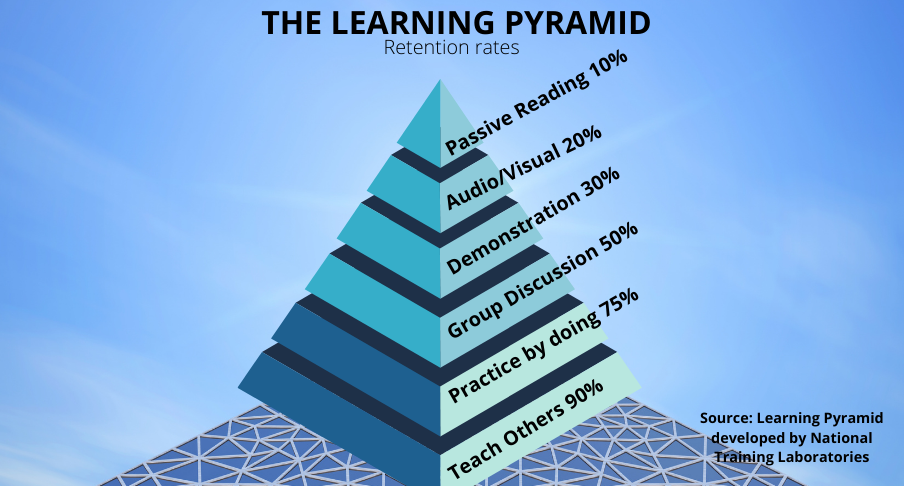What comes to your mind when you think about higher retention or higher learning power? Normally, we would go for healthy food or exercise which has been proven to be helpful to people. However, there are several other ways to sharpen your memory that help you retain more & learn faster. Being a mind trainer, I have learned and taught in my programs the methods to do so. One of them is the learning pyramid.
In 1946, An American teacher Edgar Dale who built up the Cone of Experience otherwise called the Learning Pyramid. In the mid-1960s, the National Training Laboratories Institute built up a pyramid model on its fundamental grounds in Bethel, Maine. This current NTL's model by and large shows the accompanying portrayal.
Studies show that changing your investigation strategies and materials will improve your maintenance and review of data and upgrade your learning experience. The “learning pyramid”, here and there alluded to as the “cone of learning”, created by the National Training Laboratory, recommends that most understudies just recall about 10% of what they read from course books, however, hold almost 90% of what they realize through instructing others. The Learning Pyramid model proposes that a few strategies for study are more compelling than others and that changing investigation techniques will prompt further learning and longer-term maintenance.
There are mainly two forms of learning:
Passive Learning
Passive Learning incorporates Lecture, Reading, Audio/Visual, and Demonstration. These four kinds of learning are nearly the most ordinarily utilized approach to learn information, however, their normal standard for dependability isn't also 30%.
Passive learning is when you only receive the information. The example of passive learning. Students read and absorb the material on their own time or reading from a book without encouraging much interaction or one-way lecturing.
By and large, there is the information that your cerebrum is inactively learning, your mind is taught. Your cerebrum movement is at an inactive low level. It's difficult for you to get genuine learning abilities.
challenge or opportunity welcomes us into another experience that is such an experience.
Active Learning
Active Learning incorporates Discussion Group, Practice by Doing and Teach Others, you will expand the normal consistency standard from 5% to 50%,75%, and 90%. Proposals strategies permit your cerebrum to learn information effectively, effectively think, synopsis, and enlistment. It will make you increase genuine capacity by examining with others, rehearsing, and instructing information. You will have the option to gain proficiency with a wide range of information and ace it immovably.
The Learning Pyramid

Studies show that fluctuating your investigation strategies and materials will improve your maintenance and review of data and upgrade your learning experience. The “learning pyramid”, here and there alluded to as the “cone of learning”, created by the National Training Laboratory, proposes that most understudies just recall about 10% of what they read from course books, however, hold almost 90% of what they realize through instructing others. The Learning Pyramid model recommends that a few strategies for study are more powerful than others and that fluctuating examination techniques will prompt further learning and longer-term maintenance.
Lecture
The Learning Pyramid recommends that “Talk” is one of the most inadequate techniques for learning and holding data. Talk is an aloof type of learning where you just kick back and tune in to data being coddled to you by your instructor or educator.
Reading

While more successful than Lecture, Reading is yet one of the less viable strategies for gaining and holding data, as per the Learning Pyramid. Notwithstanding, on the off chance that you are a visual student, perusing course books will probably be a more powerful learning technique for you than for understudies with non-visual learning styles.
Audio Visual
The Learning Pyramid recommends that Audio-visual learning strategies just lead to a 20% maintenance of data learned. The general media learning strategy may fuse different general media learning/encouraging apparatuses including recordings, sound, pictures, and diagrams.
Demonstration
Conversation, or “Gathering Discussion”, is a type of Cooperative Learning. It is additionally a functioning examination technique that can prompt more prominent maintenance of data and material considered and higher scholarly accomplishment.
Practice by doing, a type of “Find Learning”, is one of the best techniques for learning and study. This technique for study urges understudies to take what they realize and set up it as a regular occurrence – thereby advancing the further understanding and moving data from the present moment too long haul memory.
Discussion
On the off chance that you esteem having a growth mindset, at that point take the time and put forth the attempt to create it. Continue and openings will come. Develop flexibility in route. You are remolding your psyche and that is a pretty cool thing.
Practice (by) doing
Practice by doing, a type of “Find Learning”, is one of the best techniques for learning and study. This technique for study urges understudies to take what they realize and set up it as a regular occurrence – thereby advancing the further understanding and moving data from the present moment too long haul memory.
Educating others
The way to subject dominance is by instructing it to other people. In case you're ready to show a subject precisely and effectively to other people, you'll have a generally excellent authority of the ideas, and prevalent maintenance and review.

Conclusions
The adequacy of any learning strategy, as introduced in the Learning Pyramid, will likewise be impacted by your one-of-a-kind learning style. A few understudies hold and review data best through visual (spatial) learning, while others are aural (hear-able) students. To expand the adequacy of your considering finds your learning style. Every one of the learning strategies introduced in the Learning Pyramid is significant. Fluctuate your investigation technique and spotlight on the strategies and learning styles the yield the best outcomes for you.
Do you want to know more? Reach out to me and know about my training programs.


Really great info..thank you Dr.Manjunath sir.
Thank you sir, for sharing….my goals in life are to gain knowledge and earn money to have name name and fame, and go closer to god by practicing spirituality…
Is it good to have so many goals in life and how can I convert these goals in to single goal..?